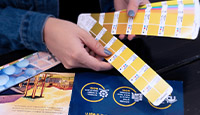Everyone knows that first impressions matter. When you meet someone for the first time, the impression that you make stays with them long after the conversation is over, playing a disproportionate role in shaping their perception of you. That’s why, when we first meet someone, many of us pay extra attention to how we look and what we say, hoping to make a good first impression. We know that, whatever impression we make, it will last.
First impressions are just as important in marketing as they are in any relationship. The first time a customer or employee interacts with a brand, they form perceptions, and those perceptions stay with them long after the interaction ends, carrying a heavier weight than impressions based on additional interactions, sometimes even cancelling them out. First impressions help shape our long-term brand loyalty, our understanding of a brand’s values and our reactions to the brand’s decisions. Make a good first impression, and your audience may forgive any stumbles in the future. Make a bad first impression, and you’ll have a hard time gaining their loyalty, no matter what you do.
At MACLYN, we’ve guided numerous clients through “brand launches.” A brand launch is simply the introduction of a brand to its audience, including both the target market (potential customers) and the employees who work for the brand’s company. In other words, it’s the moment when people get a first impression of your brand.
As we worked with our clients to launch their brands, we learned that the way you introduce a brand to its audience is just as important as the quality of the brand itself, and it deserves the same level of attention as brand development. Too often, agencies and in-house teams focus all of their time and energy on developing an excellent brand, without putting any thought into the presentation of that brand. When they do launch, the excellent brand falls flat, making a bad (or just bland) first impression. Unfortunately, an otherwise great brand can fail to reach its full potential simply because it wasn’t properly introduced. First impressions really do matter.
What makes a good brand launch “good”?
We like to think of every brand launch as two launches: an internal launch and an external launch. The “internal launch” is the introduction of the brand to the branded company’s employees, while the “external launch” refers to the introduction of the brand to everyone else, including the target market. Within those two broad categories, there is a mix of events, teasers, videos, social posts, media blitzes and numerous other executions. The mix is always different, depending on the budget and the nature of the launch.
You’ll learn more about internal and external launches in the examples below, but the general rule of thumb is that a successful brand launch plan pays close attention to both sides: internal and external. In almost every case, the internal launch should always precede the external launch, so your employees are familiar with the brand before you introduce it to the rest of the world. A successful internal brand launch gives employees a sense of ownership over the brand, strengthens company culture, and acts as a springboard for a successful external launch.
Ignoring the internal launch can be disastrous. Some companies launch their brand publicly without first introducing it to their own employees, which we think is a huge mistake. Skipping the internal introduction can make your employees think that their input isn’t being valued, because it clearly isn’t, and they may ultimately distance themselves from the brand before it’s been revealed to the public. That can have disastrous effects on the external brand launch. If your own employees don’t embrace the brand, why would anyone else? How can you expect them to convince a customer to trust your brand, if they don’t trust it themselves?
To recap: A brand launch is as important as the quality of the brand itself, and both the internal (company-wide) and external (public) sides of the brand launch are equally important.
Now that you know the ground rules of a successful brand launch, let’s take a look at a few examples. For each of the real case studies below, MACLYN guided a client through an internal and external brand launch. We’ll take you through the story of each brand launch and provide some of our key takeaways, which may come in handy the next time you prepare for launch.
Case Study 1: IMRIS

A few years ago, we partnered with the medical technology company IMRIS for a re-brand. When we first encountered IMRIS, they were on the verge of a major change. For years, the company focused entirely on engineering, selling and supporting a single flagship product: a powerful MRI scanner, mounted on the ceiling and capable of moving between operating rooms. To the rest of the industry, IMRIS was synonymous with their flagship product, the same way the company Kleenex is synonymous with tissues and Jell-o is synonymous with, well, Jell-o. And while their product continued to be popular in the world’s top surgical suites, IMRIS’ leadership knew that it was time to evolve. To be successful in the future, they had to diversify their brand now and become known for more than a single product.
First, we worked with IMRIS to develop a new brand, complete with messaging, a logo system and imagery, as well as a new website, digital marketing campaign and various collateral. The new brand was beautiful. But when it came time to launch it, we were met with a challenge.
For years, IMRIS’ employees had operated under the assumption that their brand and its flagship product were one and the same. Our new brand challenged the industry to think differently about IMRIS and their capabilities, to see the company as more than a single product. But, if we were going to convince the industry that IMRIS had a new identity, we first had to convince the company’s employees.
A few weeks before the external (public) launch, we worked with the IMRIS marketing department to create a company-wide event. We called it “The Big Think,” tying into the new brand’s brain-related theme.
The Big Think brought together nearly all of IMRIS’ employees for a three-day event in Minneapolis, home of the company’s global headquarters. The first two days were mostly meetings and break-out sessions, designed to build collaboration and help employees understand the company’s new mission. The final night was a celebration, complete with a cocktail party, a TED Talk-style address from the CEO, a one-act play, a live chalk drawing and a video that revealed the company’s new brand. The Big Think was something the employees would never forget, and it successfully introduced the new brand and generated a sense of excitement and change.
For the IMRIS brand launch, we knew that employee buy-in was important, which is why we focused heavily on the internal launch before moving on to the external. By the time we launched the brand publicly, with a digital marketing campaign, updated social accounts, a new website and a high-tech tradeshow booth, IMRIS’ employees had already adopted the company’s new identity and begun to apply it to their day-to-day work.
Lessons Learned:
- Before you launch your new brand publicly, get your employees on-board. We typically follow-up company brand launch events by sending employees emails with everything they need to know about their new brand, including the new value proposition (elevator pitch), brand guidelines and instructions for updating their personal LinkedIn accounts with the new brand elements.
- Your internal launch event is an opportunity to do more than ‘just’ launch your brand. Consider holding workshops and breakout sessions while you have all of your people together (physically or digitally), and use your event to encourage collaboration and strengthen internal processes.
- Producing an original play in a few weeks is really, really hard. Who knew?
Case Study 2: BrownWinick

Similar to IMRIS, the new BrownWinick brand represented a significant shift in the way the company presented itself, and employee buy-in was essential to the brand’s long-term success.
BrownWinick is a law firm headquartered in Des Moines, Iowa. The firm is home to some of the most respected lawyers in industries like agriculture and energy.
As any attorney will tell you, brand is especially important in the field of law, where you’re only as good as your reputation. As we developed the new BrownWinick brand, we were keenly aware that every decision we made would affect not only the overall BrownWinick brand, but also the personal brands of the firm’s attorneys. You could say there was some pressure.
Due to the nature of the law industry, we knew that each BrownWinick attorney would feel personally invested in the new brand, so we involved them as early as possible in the brand development process and continued to engage them throughout. One of the first stages of MACLYN’s brand development is Discovery, a research phase. During BrownWinick’s Discovery stage, we conducted numerous in-depth interviews and surveys with the firm’s attorneys. We used their feedback to develop the new brand, and we even pulled specific language from their interviews and baked it into the new brand’s messaging. By the time the brand was ready for launch, many of BrownWinick’s attorneys had had a hand in making it – they could hear their own voices and perspectives echoed in the brand language – and that created a sense of shared ownership and pride. The employees felt as though they had created their new brand, rather than a third party.
Before we launched the new BrownWinick brand publicly, we hosted an event for all of BrownWinick’s staff and attorneys. We held the event off-site, at a beautiful space in Des Moines’ East Village. The day of the event, work ended early, and employees were shuttled to the event space, where the party began.
After a cocktail or two, everyone took their seats. First, BrownWinick’s managing partner was welcomed to the stage, where he addressed the company, similar to the address given by the IMRIS CEO during that company’s launch event. The partner spoke about the history of the firm and described how this legacy is shaping the future of BrownWinick. “That future,” he said, “begins today with the launch of our new brand, a brand that we all had a hand in making.”
At the end of his speech, the partner introduced the evening’s guest speaker: Chris Norton. Chris is a nationally renowned motivational speaker who has published several books and been featured on The Today Show and Good Morning America. (An interesting note: Chris happens to be a client of MACLYN’s. We worked with him to develop both his motivational speaking and foundation brands, as well as his websites.)
Leading up to the event, MACLYN worked closely with Chris to connect the messaging of his speech to the new BrownWinick brand. The result was emotional and impactful, and it added unexpected depth to the messaging. Chris, who was seriously injured in a tragic accident during a high school football game, recounted his journey through crisis and hope, and described how certain people had supported and guided him through his most challenging moments. “We all encounter difficult moments in business and in life,” Chris told his audience. “That’s why it’s important to surround ourselves with people who can guide us with their wisdom and motivate us with their boldness.” (This tied neatly into the new BrownWinick brand, which centered on the core message of “Be Bold. Be Wise. BrownWinick.”)
Chris, of course, was the highlight of the evening. When he left the stage to a standing ovation, he was followed by a video that revealed the new BrownWinick brand, weaving together the themes of Chris’ speech and the managing partner’s address, all building to the reveal of the company’s new brand. As the employees watched the video, they heard echoes of the feedback they had given us during Discovery, creating a sense of shared ownership; they all had a part in this.
When BrownWinick’s staff and attorneys returned to work on Monday, their office had been transformed with new branded décor. A box of branded gear was waiting at their desk, along with an email with brand guidelines and instructions for applying the new brand to their LinkedIn profiles.
Not long after the internal brand launch, we launched the BrownWinick brand publicly, with a new website and digital marketing campaign. Similar to the IMRIS brand launch, we believe that our focus on the internal brand launch laid the groundwork for the public launch and was key to its long-term success.
Lessons Learned:
- If possible, host your company’s brand launch event off-site, away from your office. It makes it feel less like another day at the office and more like an important and exciting event.
- Get creative with your brand launch. For BrownWinick, we invited a guest speaker who had nothing to do with practicing law, but his message was inspiring and clearly relevant to the brand’s core message. Inviting an unexpected guest creates suspense and, when done thoughtfully, can add depth.
- If employee buy-in is critical, get your employees involved in the brand development process as early as possible, even during the initial research phases. They will be much more receptive to the brand if they feel that they’ve had a hand in creating it.
Case Study 3: Blooming Color

We’ll end with an example of a successful brand launch at a smaller scale. This one’s a good model for small businesses or companies with a tighter budget.
Blooming Color is a printing company headquartered in Lombard, Illinois. When you think of printing, you may not immediately think of innovation, but that’s exactly what Blooming Color is: an innovative printer. They innovate every part of the printing process, from the machines and the ink to the way customers place orders online—all to provide more capability, more efficiency and a better customer experience.
Recently, we partnered with Blooming Color to rebrand their company as an innovator and an industry leader. We developed a new brand under the core message “Ink the Impossible,” which challenges audiences to join Blooming Color in thinking bigger about printing.
When it came time to launch the brand, we knew that employee buy-in was just as important as the brand’s public appeal (a theme that you’ve heard a few times now). However, unlike IMRIS and BrownWinick, Blooming Color didn’t have the budget for a huge brand launch, so we had to think of more subtle ways to make a splash.
We started by gradually introducing the brand to the company culture. We designed clothes for employees embroidered with “Ink the Impossible” – an instant hit – and wall graphics featuring the new brand aesthetic and messaging, which appeared around the company headquarters. The brand eventually found its way around the office with pens, notebooks, calendars and a puzzle featuring the Pegasus, a creature that’s become the brand’s de facto mascot. By gradually introducing the new Blooming Color brand to the company in fun, subtle ways, employees could adopt the new brand at their own pace. That pace turned out to be pretty quick, as the brand soon became a key part of office culture and a recruiting tool. It even inspired internal company events like “Inkspiration,” which kickstarted an employee recognition program.
Like the internal brand launch, Blooming Color’s external brand launch happened through gradual changes. First, we launched a new website, followed by updated social profiles with the new look and feel, and began producing content in the style of the new brand. We reorganized the company’s capabilities messaging and featured those categories through Instagram highlight stories, and we drew new and existing audiences to our website through targeted digital advertising and social media content. Today, following the gradual but creative launch of its new brand, Blooming Color is proud of its identity as a pioneer of print.
Lessons Learned:
- You don’t need a massive budget for an effective brand launch.
- A brand launch doesn’t have to be one big event. Sometimes, it’s best to gradually weave elements of the new brand into your existing brand architecture and allow your company to adopt it.
- People seriously love mythical mascots.
We hope these lessons come in handy the next time you’re preparing for a brand launch. Clearly, with COVID-19, the big gatherings we described aren’t feasible right now, but the principles behind them are solid. Create a strategy before you launch, focus on employee buy-in, and never underestimate the value of a good first impression.
Even if you’re launching your new brand remotely, think about how you can take these principles and apply them to a digital environment. Or, give us a shout, and we’ll work through it together.
Thanks for reading!


 The Meaning of MACLYN
The Meaning of MACLYN Our Team
Our Team















 Brand Development
Brand Development Content Creation
Content Creation Graphic Design
Graphic Design Photography
Photography Web Design + Development
Web Design + Development Outsourced B2B Marketing
Outsourced B2B Marketing Strategy
Strategy SEO
SEO Search Engine Marketing
Search Engine Marketing Social Media Management
Social Media Management Content Marketing
Content Marketing Influencer Marketing
Influencer Marketing Videography
Videography Post-Production
Post-Production Screenwriting
Screenwriting Animation
Animation Earned Media
Earned Media Community Relations
Community Relations Crisis Communication
Crisis Communication





